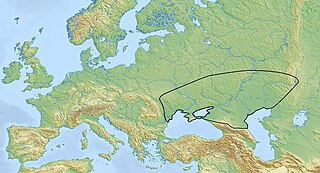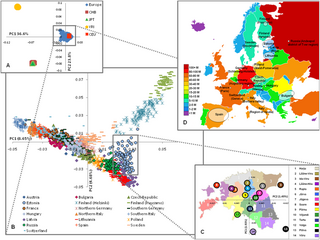Related Research Articles

Lactase is an enzyme produced by many organisms. It is located in the brush border of the small intestine of humans and other mammals. Lactase is essential to the complete digestion of whole milk; it breaks down lactose, a sugar which gives milk its sweetness. People who have deficiency of lactase, and consume dairy products, may experience the symptoms of lactose intolerance. Lactase can be purchased as a food supplement, and is added to milk to produce "lactose-free" milk products.

Lactose intolerance is a common condition caused by a decreased ability to digest lactose, a sugar found in dairy products. Those affected vary in the amount of lactose they can tolerate before symptoms develop. Symptoms may include abdominal pain, bloating, diarrhea, flatulence, and nausea. These symptoms typically start thirty minutes to two hours after eating or drinking milk-based food. Their severity typically depends on the amount a person eats or drinks. Lactose intolerance does not cause damage to the gastrointestinal tract.

The European Neolithic is the period when Neolithic technology was present in Europe, roughly between 7000 BCE and c.2000–1700 BCE. The Neolithic overlaps the Mesolithic and Bronze Age periods in Europe as cultural changes moved from the southeast to northwest at about 1 km/year – this is called the Neolithic Expansion.

Niche construction is the process by which an organism alters its own local environment. These alterations can be a physical change to the organism’s environment or encompass when an organism actively moves from one habitat to another to experience a different environment. Examples of niche construction include the building of nests and burrows by animals, and the creation of shade, influencing of wind speed, and alternation of nutrient cycling by plants. Although these alterations are often beneficial to the constructor, they are not always.

The Yamnaya culture or the Yamna culture, also known as the Pit Grave culture or Ochre Grave culture, was a late Copper Age to early Bronze Age archaeological culture of the region between the Southern Bug, Dniester, and Ural rivers, dating to 3300–2600 BCE. It was discovered by Vasily Gorodtsov following his archaelogical excavations near Siversky Donets in 1901—1903. Its name derives from its characteristic burial tradition: Я́мная is a Russian adjective that means 'related to pits ', as these people used to bury their dead in tumuli (kurgans) containing simple pit chambers.

Cheddar Man is a human male fossil found in Gough's Cave in Cheddar Gorge, Somerset, England. The skeletal remains date to around the mid-to-late 9th millennium BC, corresponding to the Mesolithic period, and it appears that he died a violent death. A large crater-like lesion just above the skull's right orbit suggests that the man may have also been suffering from a bone infection.
Lactase persistence is the continued activity of the lactase enzyme in adulthood, allowing the digestion of lactose in milk. In most mammals, the activity of the enzyme is dramatically reduced after weaning. In some human populations, though, lactase persistence has recently evolved as an adaptation to the consumption of nonhuman milk and dairy products beyond infancy. Lactase persistence is very high among northern Europeans, especially Irish people. Worldwide, most people are lactase non-persistent, and are affected by varying degrees of lactose intolerance as adults. However, lactase persistence and lactose intolerance do not always overlap.
Dual inheritance theory (DIT), also known as gene–culture coevolution or biocultural evolution, was developed in the 1960s through early 1980s to explain how human behavior is a product of two different and interacting evolutionary processes: genetic evolution and cultural evolution. Genes and culture continually interact in a feedback loop, changes in genes can lead to changes in culture which can then influence genetic selection, and vice versa. One of the theory's central claims is that culture evolves partly through a Darwinian selection process, which dual inheritance theorists often describe by analogy to genetic evolution.
Haplogroup K, formerly Haplogroup UK, is a human mitochondrial DNA (mtDNA) haplogroup. It is defined by the HVR1 mutations 16224C and 16311C. It is now known that K is a subclade of U8.
In genetics, a selective sweep is the process through which a new beneficial mutation that increases its frequency and becomes fixed in the population leads to the reduction or elimination of genetic variation among nucleotide sequences that are near the mutation. In selective sweep, positive selection causes the new mutation to reach fixation so quickly that linked alleles can "hitchhike" and also become fixed.

The Genetic history of Europe deals with the formation, ethnogenesis, and other DNA-specific information about populations indigenous, or living in Europe.

Haplogroup N1a is a human mitochondrial DNA (mtDNA) haplogroup.
The genetic history of the British Isles is the subject of research within the larger field of human population genetics. It has developed in parallel with DNA testing technologies capable of identifying genetic similarities and differences between both modern and ancient populations. The conclusions of population genetics regarding the British Isles in turn draw upon and contribute to the larger field of understanding the history of the human occupation of the area, complementing work in linguistics, archaeology, history and genealogy.
Joachim Burger is a German anthropologist and population geneticist based at Johannes Gutenberg University, Mainz, Germany, where he runs the Palaeogenetics Group at the Institute of Organismic and Molecular Evolution (iOME).

Recent human evolution refers to evolutionary adaptation, sexual and natural selection, and genetic drift within Homo sapiens populations, since their separation and dispersal in the Middle Paleolithic about 50,000 years ago. Contrary to popular belief, not only are humans still evolving, their evolution since the dawn of agriculture is faster than ever before. It has been proposed that human culture acts as a selective force in human evolution and has accelerated it; however, this is disputed. With a sufficiently large data set and modern research methods, scientists can study the changes in the frequency of an allele occurring in a tiny subset of the population over a single lifetime, the shortest meaningful time scale in evolution. Comparing a given gene with that of other species enables geneticists to determine whether it is rapidly evolving in humans alone. For example, while human DNA is on average 98% identical to chimp DNA, the so-called Human Accelerated Region 1 (HAR1), involved in the development of the brain, is only 85% similar.
Allele age is the amount of time elapsed since an allele first appeared due to mutation. Estimating the time at which a certain allele appeared allows researchers to infer patterns of human migration, disease, and natural selection. Allele age can be estimated based on (1) the frequency of the allele in a population and (2) the genetic variation that occurs within different copies of the allele, also known as intra-allelic variation. While either of these methods can be used to estimate allele age, the use of both increases the accuracy of the estimation and can sometimes offer additional information regarding the presence of selection.
In archaeogenetics, the term Eastern Hunter-Gatherer (EHG), sometimes East European Hunter-Gatherer, or Eastern European Hunter-Gatherer is the name given to a distinct ancestral component that represents descent from Mesolithic hunter-gatherers of Eastern Europe. During the Mesolithic, the EHGs inhabited an area stretching from the Baltic Sea to the Urals and downwards to the Pontic–Caspian steppe.
Sarah Anne Tishkoff is an American geneticist and the David and Lyn Silfen Professor in the Department of Genetics and Biology at the University of Pennsylvania. She also serves as a director for the American Society of Human Genetics and is an associate editor at PLOS Genetics, G3, and Genome Research. She is also a member of the scientific advisory board at the David and Lucile Packard Foundation.
Richard Evershed is a Professor of Biogeochemistry and Fellow of the Royal Society.
References
- ↑ "UCL – University College London". 13 February 2019.
- ↑ Prof Mark Thomas Archived 2010-09-29 at the Wayback Machine , UCL School of Life and Medical Sciences
- ↑ "UCL – University College London". 13 February 2019.
- ↑ Hagelberg et al., 1994; Thomas et al., 2000a
- ↑ Thomas et al., 2000b.
- ↑ Weale et al., 2002.
- ↑ Thomas et al., 2006
- ↑ Charlotte A. Mulcare, Michael E. Weale, Abigail L . Jones, Bruce Connell, David Zeitlin, Ayele Tarekegn, Dallas M. Swallow, Neil Bradman and Mark G. Thomas (2004) The T allele located 13.9 kb upstream of the lactase gene (LCT) (C-13.9kbT) does not predict or cause the lactase persistence phenotype in Africans. [ permanent dead link ] American Journal of Human Genetics 74: pp1102–1110.
- ↑ J. Burger, M. Kirchner, B. Bramanti, W. Haak, M. G. Thomas (2007) Absence of the Lactase-Persistence associated allele in early Neolithic Europeans Archived 2008-10-31 at Archive-It . Proceedings of the National Academy of Sciences USA 104: pp3736-3741.
- ↑ Yuval Itan, Adam Powell, Mark A. Beaumont, Joachim Burger and Mark G. Thomas (2009) The Origins of Lactase Persistence in Europe [ permanent dead link ]. PLoS Comput Biol 5(8): e1000491.
- ↑ Powell, A., Shennan, S., and Thomas, M.G. (2009) Late Pleistocene Demography and the Appearance of Modern Human Behavior. Science 324: pp. 1298–1301
- ↑ Blood and Treasure [ permanent dead link ], The Economist, Jun 4th 2009
- ↑ "Brining to light patterns of migration from 6 000 to 500 BC". Community Research and Development Information Service (CORDIS).